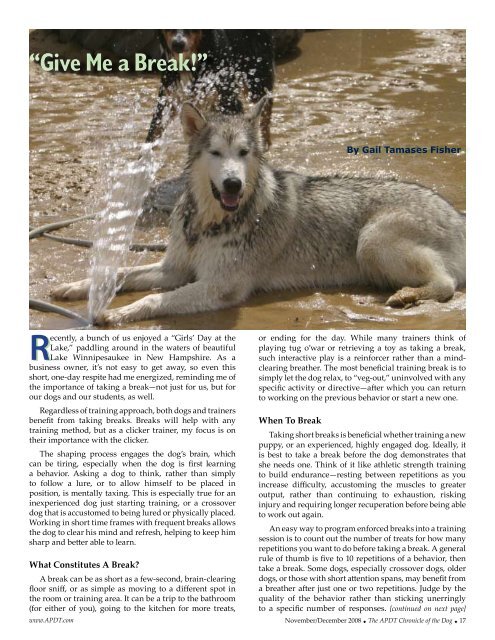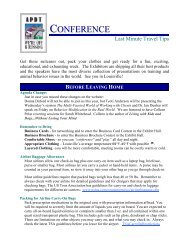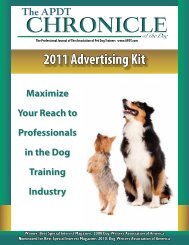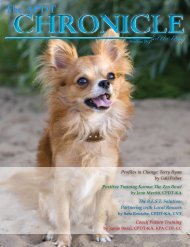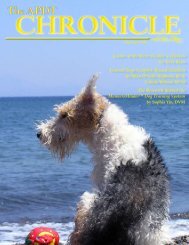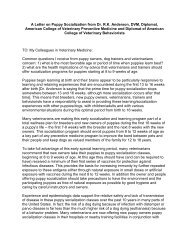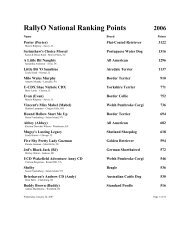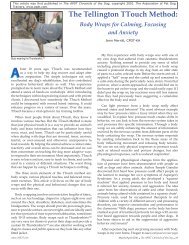of the Dog - Association of Pet Dog Trainers
of the Dog - Association of Pet Dog Trainers
of the Dog - Association of Pet Dog Trainers
You also want an ePaper? Increase the reach of your titles
YUMPU automatically turns print PDFs into web optimized ePapers that Google loves.
“Give Me a Break!”<br />
Recently, a bunch <strong>of</strong> us enjoyed a “Girls’ Day at <strong>the</strong><br />
Lake,” paddling around in <strong>the</strong> waters <strong>of</strong> beautiful<br />
Lake Winnipesaukee in New Hampshire. As a<br />
business owner, it’s not easy to get away, so even this<br />
short, one-day respite had me energized, reminding me <strong>of</strong><br />
<strong>the</strong> importance <strong>of</strong> taking a break—not just for us, but for<br />
our dogs and our students, as well.<br />
Regardless <strong>of</strong> training approach, both dogs and trainers<br />
benefit from taking breaks. Breaks will help with any<br />
training method, but as a clicker trainer, my focus is on<br />
<strong>the</strong>ir importance with <strong>the</strong> clicker.<br />
The shaping process engages <strong>the</strong> dog’s brain, which<br />
can be tiring, especially when <strong>the</strong> dog is first learning<br />
a behavior. Asking a dog to think, ra<strong>the</strong>r than simply<br />
to follow a lure, or to allow himself to be placed in<br />
position, is mentally taxing. This is especially true for an<br />
inexperienced dog just starting training, or a crossover<br />
dog that is accustomed to being lured or physically placed.<br />
Working in short time frames with frequent breaks allows<br />
<strong>the</strong> dog to clear his mind and refresh, helping to keep him<br />
sharp and better able to learn.<br />
What Constitutes A Break?<br />
A break can be as short as a few-second, brain-clearing<br />
floor sniff, or as simple as moving to a different spot in<br />
<strong>the</strong> room or training area. It can be a trip to <strong>the</strong> bathroom<br />
(for ei<strong>the</strong>r <strong>of</strong> you), going to <strong>the</strong> kitchen for more treats,<br />
www.APDT.com<br />
or ending for <strong>the</strong> day. While many trainers think <strong>of</strong><br />
playing tug o’war or retrieving a toy as taking a break,<br />
such interactive play is a reinforcer ra<strong>the</strong>r than a mindclearing<br />
brea<strong>the</strong>r. The most beneficial training break is to<br />
simply let <strong>the</strong> dog relax, to “veg-out,” uninvolved with any<br />
specific activity or directive—after which you can return<br />
to working on <strong>the</strong> previous behavior or start a new one.<br />
When To Break<br />
By Gail Tamases Fisher<br />
Taking short breaks is beneficial whe<strong>the</strong>r training a new<br />
puppy, or an experienced, highly engaged dog. Ideally, it<br />
is best to take a break before <strong>the</strong> dog demonstrates that<br />
she needs one. Think <strong>of</strong> it like athletic strength training<br />
to build endurance—resting between repetitions as you<br />
increase difficulty, accustoming <strong>the</strong> muscles to greater<br />
output, ra<strong>the</strong>r than continuing to exhaustion, risking<br />
injury and requiring longer recuperation before being able<br />
to work out again.<br />
An easy way to program enforced breaks into a training<br />
session is to count out <strong>the</strong> number <strong>of</strong> treats for how many<br />
repetitions you want to do before taking a break. A general<br />
rule <strong>of</strong> thumb is five to 10 repetitions <strong>of</strong> a behavior, <strong>the</strong>n<br />
take a break. Some dogs, especially crossover dogs, older<br />
dogs, or those with short attention spans, may benefit from<br />
a brea<strong>the</strong>r after just one or two repetitions. Judge by <strong>the</strong><br />
quality <strong>of</strong> <strong>the</strong> behavior ra<strong>the</strong>r than sticking unerringly<br />
to a specific number <strong>of</strong> responses. [continued on next page]<br />
November/December 2008 w The APDT Chronicle <strong>of</strong> <strong>the</strong> <strong>Dog</strong> w 17


